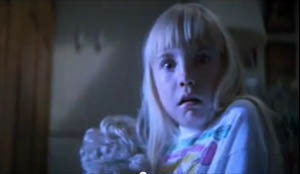|
The original Poltergeist was one of the scariest filmgoing experiences of my young life. Poltergeist 2 was, by contrast, one of my first encounters with the phenomenon of the thoroughly unnecessary sequel. It has its heart in the right place, but its brains were seemingly shipped out of town. 
Barely five minutes into the film, my fifteen year-old self was already having difficulties in the area of suspended disbelief. Not because of the ghosts, for which I'm perfectly willing to suspend disbelief in a ghost movie, but because of the plot contrivances I was being expected to accept. Tangina Barrons, the diminiuative medium from the first film, has had the ground where the Freeling home once stood excavated, and has found a chamber full of bodies buried deep under the cemetary. This is the first overtly ridiculous plot point we're asked to buy into. We believed at the end of the original film that the house was possessed by spirits because it was built atop a graveyard, but apparently not. Apparently, under the graveyard, there was a second graveyard which was actually the source of all the trouble, and the presence of the topmost graveyard was merely to be filed in the category of "head-slapping coincidence." Meanwhile, fleeing their former existence and still without a home of their own, Steven and Diane Freeling have sought refuge at Diane's mother's home, along with their two children, Robbie and Carol Anne. Eldest daughter Dana has apparently ceased to exist without anyone noticing. In real life, the actress was tragically murdered (the first incident in the absurd "Poltergeist curse" urban legend), but rather than recasting the part or explaining her absence, the film simply glosses her over like an inconvenient detail. The second member of the "curse" roster shortly arrives in the form of the intinerant preacher Kane, though I utterly fail to believe that Julian Beck's death shortly after filming came as a surprise to anyone. He's the most cadaverous-looking actor I've ever seen in a film and is one of its most effective scares, which is of course why the director keeps showing him walking through people and magically appearing and disappearing, as if we weren't already fully prepared to accept him as a malefic being. 
An American Indian shaman arrives and counsels Steven on how to become a warrior. With Diane having performed the more grueling tasks needed to save the family in the first film, Steven suffers from feelings of inadequacy and a need to be the family's protector. Giving more weight and a specific story arc to the lesser-developed of the parents is the sort of thing a sequel should do, and is a good idea. Having Robbie attacked when ghosts possess the wires in his braces is not a good idea, unless your intention is to make a comedy. In an effective early scene, Carol Anne instinctively hands her grandmother the requested-colored yarn without looking at it. In a wholly ridiculous continuation of the motif, Tangina pushily asserts that Diane is "highly clarivoyant" like her mother and daughter, after which Diane is able to see, in full Technicolor perfection, the sad story of Kane and his ill-fated flock from a century earlier. That level of clarivoyance is the sort of thing, one suspects, that would've been noticed by an individual previously. The writers seem to have remembered the original Poltergeist's more flamboyant moments and forgotten its subtler ones. Scare scenes tend towards the pop-up corpse-in-a-box variety. The film shows signs of a nightmarish editing process: a bevy of ghosts materializes on the lawn and begins to hoof it the rest of the way to the house (why they couldn't have simply materialized inside it is anyone's guess), only to never get there. The movie simply moves on to a new scene before we find out what it was all about. The ending is stunning. By this, I don't mean that it is powerful or beautiful, but rather that I was literally quite stunned when the film ended, as right up until the very moment that the credits began to roll, I sincerely did not believe that it was actually over. So anticlimactic was the finale that I dismissed it as the typical false ending so prevalent in horror films. The titular "other side" resembles Star Trek 2's Mutara Nebula, where the Freelings fight the evil Reverend Kane with a combination of love power and some sort of enchanted spear. Indeed, when the family engages in a zero-G group hug and begins radiating golden light to the swelling strains of isn't-it-just-so-inspirational music, the film achieves a level of corniness so profound that audience members may blush. The final fight contains one stellar special effect, wherein Carol Anne's face appears to morph, in a single shot, to that of a rotting corpse. I say "appears" because the first genuine computer-assisted morphing effect was still three years away when Poltergeist 2 was released. It's truly creepy, though it would've been even more effective if I could've said what it was supposed to signify. -review by Matt Murray
|
|
||||||||